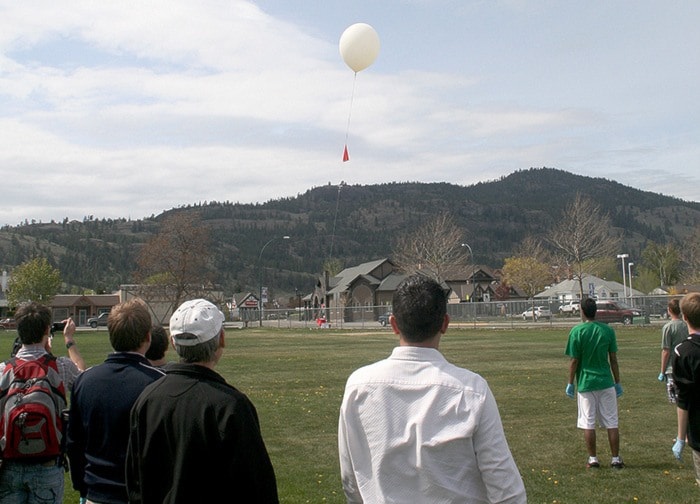The flight of a helium balloon on May 2 was considerably shorter and less spectacular than anticipated.
The balloon was launched from the field behind Summerland Secondary School on Thursday afternoon.
Earlier predictions and computer models had called for a flight time of 2.5 hours, covering a distance of 100 to 150 kilometres and reaching an elevation of more than 34,000 metres.
The actual flight was much shorter.
The balloon was airborne around 30 seconds, reached an altitude of around two metres and travelled one block before it became entangled in a light standard at the corner of Jubilee Road and Kelly Avenue.
“We didn’t quite reach our goal of 100,000 feet,” said Trevor Knowlton, careers teacher at the high school and coordinator of the balloon project. “We cleared a six-foot fence.”
He said the doomed flight ended early because the payload was too heavy.
Initially, organizers at the school had worked on a two-kilogram payload, but Transport Canada required them to include an aircraft transponder with the rest of the payload.
The transponder, which includes the electronic unit, a battery and a length of cable, roughly doubled the weight of the load.
“Having that equipment on board pushed us over the top,” Knowlton said.
The balloon was rated to carry a payload of up to 2.7 kilograms.
Before the launch, Knowlton and others working with the balloon project filled the balloon as full as possible and attempted to lighten the load, but the payload was still too much for the balloon to handle.
“We pushed the balloon in terms of how much helium it took,” he said.
The strong south wind on Tuesday afternoon was a small factor in the crash, but Knowlton said the flight would have been doomed even if the wind had been calm.
He said the school may attempt a launch again next year, but changes would be made.
In order to lift the payload, a larger balloon, one rated for three to four kilograms would be used.
The video from the launch will be edited and will then be sent to the International Space Station.
Knowlton said the preparation done by the students was impressive.
“We did our best,” he said. “It was a good team effort.”
